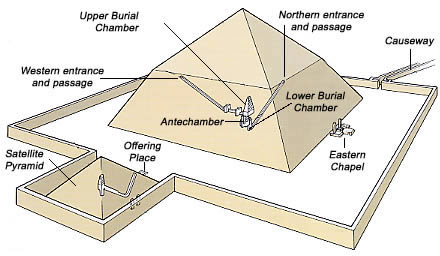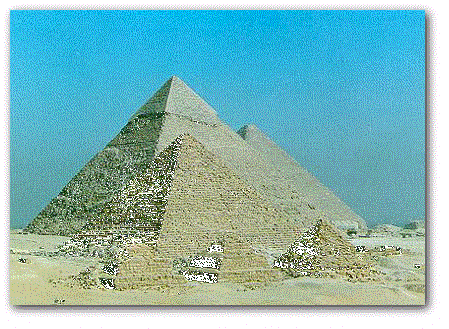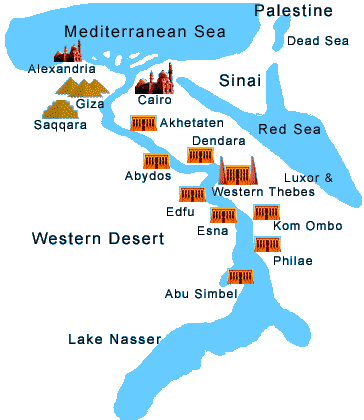| Daily Life |
|
|
Different Types of Pyramids
|
|
Step Pyramid |

The architect, Imhoptep, designed the first step pyramid at Saqqara for Pharaoh Djoser in 2600 BC. The bent pyramid was a stage in the development of the true pyramid.
|
|
Bent Pyramid |
 |
|
|
Khufu's Great Pyramid, the biggest of three massive pyramids at Giza, is the largest stone building in the world. It is 146 m (479 ft) high and contains nearly two and a half million blocks of limestone. It probably took more than 20 years to complete Pharaoh Khufu's Great Pyramid. |
Khufu's Great Pyramid
|

The great pyramids of Giza, symbols of the mysterious land of Egypt, were built around 2700-2500 BC as tombs for the pharaohs (rulers of ancient Egypt, who held the status of gods on earth). The Great Pyramid of Khufu (Cheops to the Greeks) is the largest, pictured here in the center of the photograph, it covers 13 acres. It was constructed of around 2.3 million stones and each of the stones weigh from 2 to 30 tons each. Khufu was also the first pharaoh to be mummified.
All three of the main pyramids - of kings Khufu (Cheops), Khaefra (Chephren) and Menkaura (Mycerinus) - were broken into in antiquity and all of their wonderful treasures stolen. Apart from stone sarcophagi, they now all lie empty.
DID YOU KNOW: The Pyramids of Egypt, built at Giza during the 4th Dynasty are the oldest of the seven wonders of the ancient world and the only ones remaining intact today.
The Ancient Egyptians were among the first people to build in stone. They erected huge temples, tombs and pyramids which were some of the biggest buildings in the ancient world. These were constructed so well that they have lasted many thousands of years.
DID YOU KNOW: Tombs had false doors decorated with prayers and the owners' names. To speak the name of the dead is to make the deceased live again. They were sacred places for the living to leave offerings for the dead.
Pyramids are not the only large stone structures built by early Egyptians. Pyramids were the centrepieces for large building complexes of tombs and temples for worshipping their gods. Egyptians also made some very large temples. The Great Temple at El-Karnak, built more than 3000 years ago, is larger than the Cathedral of Notre Dame in Paris.
DID YOU KNOW: Pyramids were originally cased in fine white limestone from Turah. The pyramid's base was square; the four sides almost identical in length. The workers built the core first, then they dragged the facing blocks up ramps, working from the top downwards.
DID YOU KNOW: Treasure from successful military expeditions helped pay for the temple of Amun - Re at Karnak. Central columns, higher thaan a nine - storey building, are crowned with carved papyrus heads. The walls are inscribed with records of Sethos I's battle victories. The grounds once included gardens, orchards and living quarters for temple workers,
The tombs in the Valley of the Kings were made by royal workers who lived at Deir er-Medina. This village existed for the 500 years or so that the pharaohs were buried in their desert retreat. Scribal records tell us that the well-organised workforce was paid with government provisions and had one day off in ten. Craftspeople often had highly decorated tombs of their own and were buried with attractive grave goods, such as painted terracotta jars.
DID YOU KNOW: Not all Egyptians were buried in pyramids. The earliest graves were simple holes in the sand, with stones piled on top. Then came 'mastabas', house-shaped mud brick tombs and later on these were developed into pyramids. Sometimes Egyptian nobles were buried in tombs cut into the rock face.
![]()
The Sphinx
The Sphinx has come to symbolise the awesome grandeur of the monuments created by ancient Egyptian civilisation. It was carved in about 2500 BC out of a natural outcrop of rock in the same limestone quarries at Giza from which the blocks were hewn to build the great pyramids. For most of its life, the Sphinx was buried right up to its neck in sand. Its face is that of King Khaefra and is situated outside his pyramid. This huge 19.8 metres (65ft) high and 73.2 metre (240 ft) long Sphinx, cut from rock, facing East, was believed to guard the pyramids at Giza from tomb robbers. In later years, three tunnels have been discovered within the Sphinx's body. The statue had a human head, representing intelligence, on a lion's body, a sign of strength. Together they symbolised royal power.


The head of the Sphinx was damaged by cannon fire in about 1380 AD by a Muslim ruler, who perhaps considered the statue a blasphemy against the Islamic law prohibiting the representation of living beings.
The ancient Egyptians believed the goddess Meretseger guarded the Valley of the Kings. She was represented as a cobra and her venom was supposed to blind or poison grave robbers and so protect the tombs.

| Daily Life |